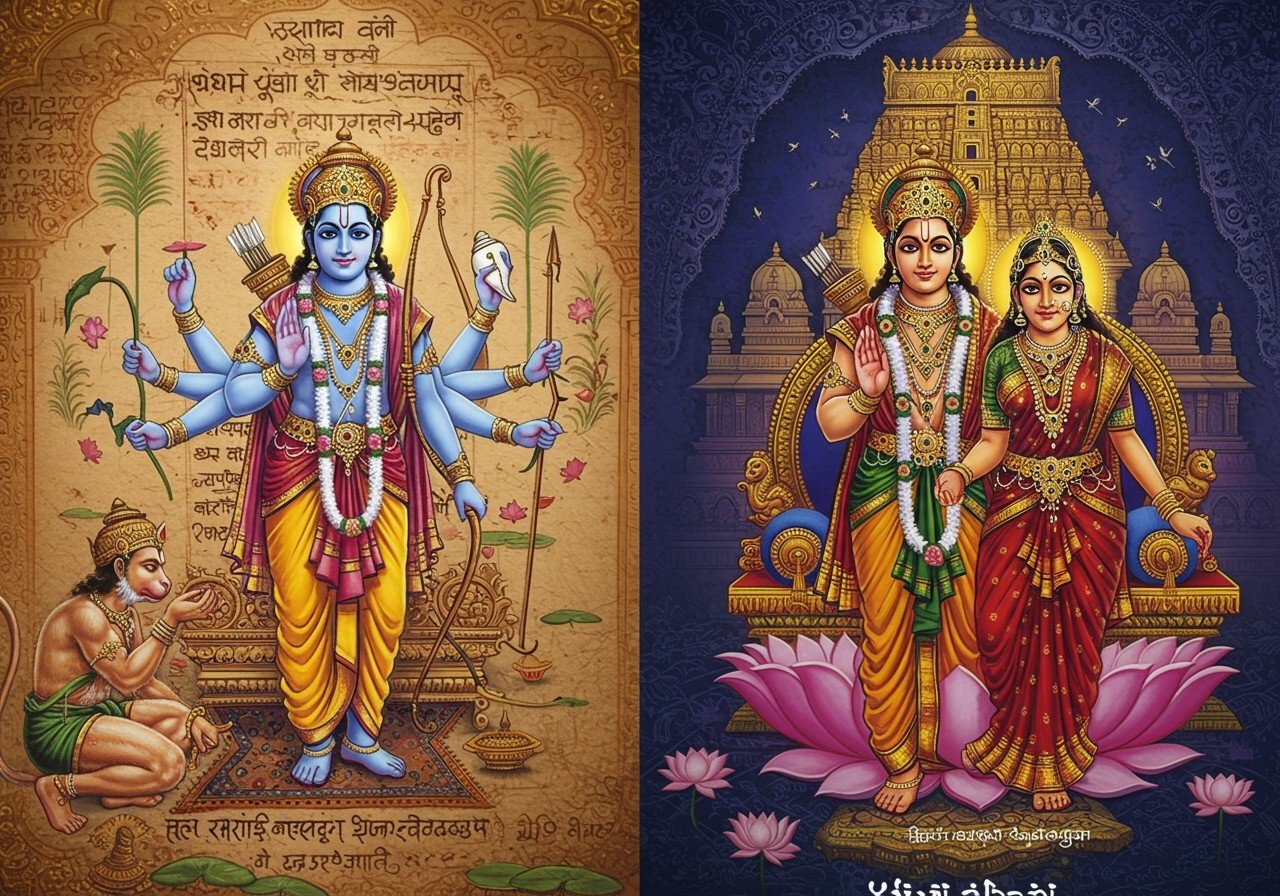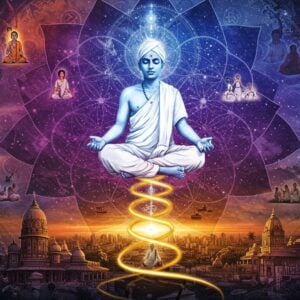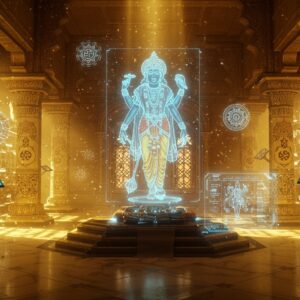
Understanding the Ramayana is deeply woven into the fabric of Indian tradition. The Valmiki Ramayana and the Kamba Ramayanam stand as two celebrated versions of this epic narrative. While they share the fundamental storyline of Lord Rama’s journey, there are fascinating nuances and interpretations that set them apart. Delving into these differences can enrich your understanding and appreciation of both these literary treasures.
Origins and Authorship: Tracing the Lineage
Valmiki’s Work: The Original Epic
The Valmiki Ramayana, attributed to the sage Valmiki, is considered the original version, composed in Sanskrit. It holds immense significance as a literary and spiritual cornerstone across India, revered for its poetic beauty and profound teachings.
Kambar’s Contribution: A Tamil Masterpiece
Centuries later, in the 12th century, the Tamil poet Kambar graced the world with the Kamba Ramayanam. This adaptation introduced the epic to Tamil-speaking regions, enriching it with distinct linguistic and cultural elements that resonate deeply with the local ethos.
Both versions are deeply embedded in Indian culture, with Valmiki’s work reflecting a pan-Indian perspective, while Kambar’s version embraces Tamil traditions, showcasing the vibrant diversity within Indian literature. This interplay of perspectives allows for a deeper exploration of the epic’s themes and their resonance across different cultural landscapes.
Language and Style: A Symphony of Words
Sanskrit vs. Tamil: The Melody of Languages
Composed in Sanskrit, the Valmiki Ramayana employs the ‘Anushtubh’ meter, giving it a rhythmic and lyrical flow. Kamba Ramayanam, written in Tamil, introduces the Viruttam and Santham styles, emphasizing tempo and tune, creating a musicality that captures the heart.
Poetic Expressions: Painting Vivid Pictures
Kambar’s rich use of similes and metaphors paints vivid pictures, appealing to Tamil aesthetic sensibilities. His elaborate descriptions bring the story to life, resonating with the cultural nuances of the region. Valmiki’s style, while more direct, is deeply evocative, capturing the imagination with its simplicity and profound emotional depth.
Character Portrayal and Themes: Exploring the Human and the Divine
Depiction of Key Figures: Nuances in Character
Valmiki presents Rama as a noble human prince, while Kambar portrays him as an avatar of Vishnu, reflecting the different theological perspectives within Hinduism. Kambar’s Sita possesses greater agency, a strong and decisive character who navigates the challenges with resilience. Ravana, too, takes on different shades; Valmiki’s Ravana is driven by vengeance, while Kambar’s Ravana is a complex ruler, undone by a mixture of love and lust for Sita.
Themes of Dharma and Devotion: Navigating Life’s Path
Both versions delve into the timeless themes of dharma (righteous conduct), devotion, and divine intervention. Kamba Ramayanam, influenced by the Bhakti movement, emphasizes devotion to Rama as a path to spiritual liberation, reflecting the religious fervor of the time. These themes resonate deeply with Indian spirituality, offering guidance on navigating life’s complexities and finding solace in devotion.
Cultural and Regional Influences: A Tapestry of Traditions
Regional Elements in Kamba Ramayanam: Embracing Local Flavors
Kambar seamlessly weaves Tamil customs and societal norms into his narrative. Descriptions of local flora and fauna ground the epic in the familiar landscape of Tamil Nadu, resonating deeply with the cultural ethos of the region. This regional touch makes Kamba Ramayanam an integral part of Tamil literary heritage.
Valmiki’s Pan-Indian Perspective: A Unifying Narrative
Valmiki’s version maintains a broader, pan-Indian perspective, appealing to a wider audience across the subcontinent. It acts as a unifying narrative that transcends regional boundaries, bringing together diverse communities through a shared cultural heritage.
Narrative Structure and Additions: Shaping the Epic’s Flow
Structural Differences: Unique Approaches to Storytelling
Valmiki’s Ramayana unfolds across seven Kandas (books), including the Uttara Kanda. Kamba Ramayanam comprises six Kandas, culminating in the Yudha Kanda, omitting the Lava Kusa story but incorporating distinct episodes like Hiranyan’s killing. These structural variations reflect different narrative choices, adding unique layers to each version.
Kambar’s Padalams: Detailed Explorations
Kambar’s division of the narrative into 123 Padalams allows for deeper exploration of specific events. His embellishments, especially in the depiction of battles, enhance the dramatic intensity and emotional depth of the story. This detailed approach allows readers to immerse themselves in the epic’s unfolding drama.
Religious and Philosophical Interpretations: Layers of Meaning
Philosophical Undercurrents: Exploring Spiritual Depths
Kamba Ramayanam explicitly emphasizes Rama’s divinity, aligning with the Vaishnavite traditions prevalent in Tamil Nadu. This portrayal of Rama as an incarnation of Vishnu reinforces themes of devotion and surrender, providing a spiritual lens through which to understand the epic’s message.
Diverse Interpretations: A Rich Tapestry of Beliefs
These interpretations resonate with diverse religious beliefs across India, enriching the epic’s spiritual dimensions and offering various pathways to understanding its profound messages. The Ramayana invites readers to engage with its philosophical depths and draw inspiration from its timeless wisdom.
Kamba Ramayanam vs. Valmiki Ramayana: A Comparative Glance
- Origin: Valmiki Ramayana (Original Sanskrit); Kamba Ramayanam (Tamil adaptation)
- Rama’s Nature: Valmiki (Human prince); Kambar (Incarnation of Vishnu)
This fundamental difference shapes the way each version portrays Rama’s journey and his interactions with the world. - Structure: Valmiki (Seven Kandas); Kambar (Six Kandas, 123 Padalams)
The structural variations reflect distinct narrative approaches, offering different perspectives on the epic’s unfolding events. - Poetic Style: Valmiki (‘Anushtubh’ meter); Kambar (Viruttam and Santham styles)
The poetic styles contribute to the unique rhythm and musicality of each version, enriching the reading experience. - Character Portrayal: Kambar emphasizes Sita’s agency and presents a more nuanced Ravana.
These differences offer deeper insights into the characters’ motivations and complexities. - Religious Significance: Kambar’s version strengthens Rama worship in Tamil Nadu.
This highlights the regional impact of Kamba Ramayanam and its contribution to religious practices.
How Poojn.in Helps You Connect with Ramayana Traditions
At Poojn.in, we understand the profound significance of both the Kamba Ramayanam and Valmiki Ramayana in Hindu culture. We offer a curated collection of sacred items to enhance your spiritual practice and connection with these timeless epics. Whether you follow Valmiki’s Sanskrit verses or Kambar’s Tamil rendition, our authentic, ritual-grade products are designed to support your devotional journey.
Explore our collection:
- Authentic Ram Darbar idols for reverence in your home
- Sacred texts of Valmiki Ramayana in multiple languages
- Traditional puja items for Ram Navami celebrations
- Pure copper and brass items for offerings
- Special Ram Raksha yantra and protection amulets
Personalized Guidance:
For assistance in selecting the most appropriate items for your Ramayana-related pujas, our knowledgeable team is here to help. We understand the nuances of different traditions and can guide you in choosing items that align with your specific practices. All our products are accompanied by authenticity certificates and are packaged with utmost care to preserve their sanctity during transit.
Contact us:
Call: 03369029784
WhatsApp: 9476142738
Visit Poojn.in to explore our complete collection of Ramayana-related puja items and spiritual products. We offer secure online payment options and ship across India for your convenience.
Conclusion: The Enduring Legacy of the Ramayana
The Ramayana, in its various forms, remains a cherished epic that continues to inspire millions across India and beyond. Both Kamba Ramayanam and Valmiki Ramayana provide unique perspectives on this timeless tale, enriching our understanding of dharma, devotion, and human values.
Valmiki’s version, with its universal themes, serves as a unifying force, binding the subcontinent with shared cultural threads. Kambar’s adaptation adds a vibrant Tamil dimension, resonating deeply with regional audiences and enriching the epic’s tapestry.
Exploring both versions allows us to appreciate the depth and adaptability of the Ramayana, a narrative that transcends time and cultural boundaries. Whether through Valmiki’s evocative simplicity or Kambar’s lyrical grandeur, the core message of the Ramayana continues to resonate, guiding us on our own life journeys.
Frequently Asked Questions about the Kamba Ramayanam and Valmiki Ramayana
What distinguishes the Kamba Ramayanam? The Kamba Ramayanam stands out as a Tamil retelling of the Ramayana by the poet Kambar. It focuses on Lord Rama’s story while interweaving details and interpretations unique to Tamil culture, offering a fresh perspective on the epic.
Who authored the Valmiki Ramayana? Sage Valmiki is credited with composing the Valmiki Ramayana, the original Sanskrit version. It is widely regarded as the most authentic account of Lord Rama’s life and serves as the foundation for later adaptations.
How does the Kamba Ramayanam differ from the Valmiki Ramayana? Beyond the language difference (Tamil for Kamba Ramayanam, Sanskrit for Valmiki Ramayana), Kambar’s version incorporates dramatic elements and embellishments that cater to Tamil cultural sensibilities. The portrayal of certain characters and events differs, adding unique flavors to each version.
Do the narratives in both versions align? The core narrative of Lord Rama’s journey remains consistent in both versions. However, Kamba Ramayanam offers additional details, character developments, and interpretations that set it apart from the Valmiki Ramayana, providing a deeper dive into specific aspects of the story.
Why are there multiple versions of the Ramayana? The existence of different versions, like the Kamba Ramayanam and Valmiki Ramayana, reflects the cultural and linguistic diversity across regions. Each version adapts to the traditions and values of its audience, making the epic accessible and relatable to different communities.
Is Kamba Ramayanam more popular in South India? Yes, the Kamba Ramayanam holds a special place of reverence in Tamil Nadu and surrounding South Indian regions. Its Tamil language and the integration of local customs contribute to its popularity in these areas.
Which version predates the other? The Valmiki Ramayana, originating in ancient India, is the older version. It serves as the source text that inspired later adaptations, including the Kamba Ramayanam.
Can both versions be accessed online? Yes, both the Kamba Ramayanam and Valmiki Ramayana are available online. This accessibility allows readers from across the globe to connect with these timeless epics and explore their rich spiritual and literary heritage.


